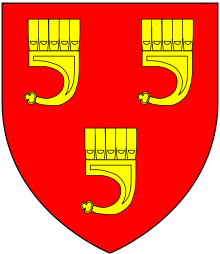
Back ريتشارد غرينفيل Arabic Richard Grenville German Richard Grenville Spanish Richard Grenville French ריצ'רד גרנוויל HE Ռիչարդ Գրենվիլ Armenian Richard Grenville Italian Richard Grenville Dutch Richard Grenville Polish Гренвилл, Ричард Russian
This article includes a list of general references, but it lacks sufficient corresponding inline citations. (January 2010) |
Sir Richard Grenville | |
|---|---|
 Contemporary portrait of Sir Richard Grenville, inscribed: An(no) D(omi)ni 1571 aetatis suae 29 ("In the year of Our Lord 1571, of his age 29"). National Portrait Gallery, London. | |
| Born | 15 June 1542 Bideford, Devon, England |
| Died | 10 September 1591 (aged 49) Flores, Azores Islands |
| Allegiance | |
| Service | |
| Rank | Admiral |
| Commands | Revenge |
| Battles / wars | Second Desmond Rebellion Anglo–Spanish War (1585) Battle of Gravelines Battle of Flores (1591) |
| Spouse(s) | Mary St Leger |
| Relations | Son Bernard Grenville |


Sir Richard Grenville (15 June 1542 – 10 September 1591), also spelt Greynvile, Greeneville, and Greenfield, was an English privateer and explorer. Grenville was lord of the manors of Stowe, Cornwall and Bideford, Devon. He subsequently participated in the plantations of Ireland specifically the Munster plantations, the English colonisation of the Americas and the repulse of the Spanish Armada.
Grenville also served as Member of Parliament for Cornwall, High Sheriff for County Cork and Sheriff of Cornwall. In 1591, Grenville died at the battle of Flores fighting against an overwhelmingly larger Spanish fleet near the Azores. He and his crew on board the galleon Revenge fought against the 53-strong Spanish fleet to allow the other English ships to escape. Grenville was the grandfather of Sir Bevil Grenville, a prominent military officer during the English Civil War.